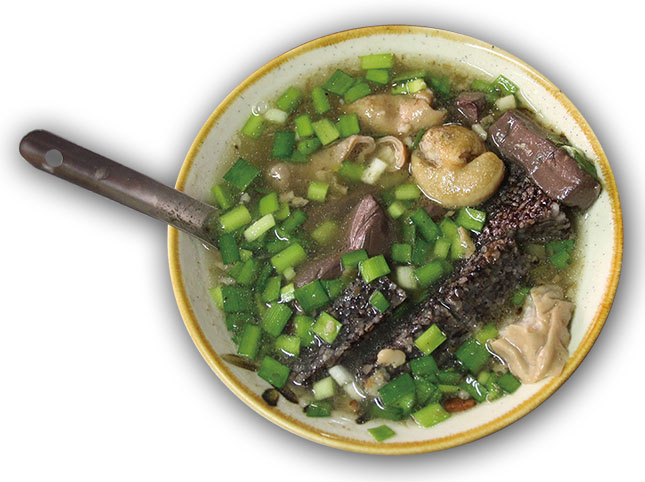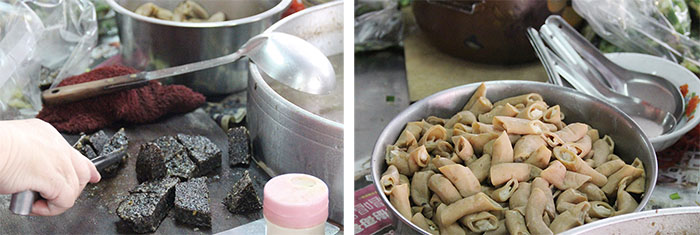A Beloved Traditional Dish: Pig-Blood Soup/傳統古早味─豬血湯
A Beloved Traditional Dish: Pig-Blood Soup
◎English translation: Peng Hsin-yi

◎Photos by quava
If you get off the train at Lujhu Railway Station, and walk along Jhongjheng Road, you will soon find Auntie A-Liu's Pig-Blood Soup on the right in the middle of the market. A space shielded by a big plastic tarp houses four food stalls: The one in the front serves a soup made with white wood-ear (also known as snow fungus), a sweet treat that can be eaten hot or cold; the spot to the right offers "tutuo fish soup," featuring chunks of narrow-barred Spanish mackerel (tutuo) battered and fried and then dunked in starch-thickened soup; the spot to the left offers vermicelli soup with lamb. Auntie A-Liu's is right in the middle, and invariably there is a queue in front of it.
The owner-chef and her helpers are always very busy. With practiced moves, they scoop out pig-blood tofu and pig-blood rice pudding from a steaming caldron, then put these delicacies and stock into plastic bags already filled with Chinese chives and pickled mustard green. The table to their left supports a simmering pot of meat sauce and three or four side dishes. There, another two ladies assemble meat sauce over rice to order. These ladies have been working together for years, and their moves are perfectly synchronized. Whether you want to eat in or purchase a takeout, they make sure you are served very quickly.
Pig's blood is rich in protein and low in fat, and thus healthy if consumed in moderation. The owner says the recipe came from her grandmother, and it has been around for more than 60 years now. In the early days, the family sold pork in the market in the morning, and used the same space to sell pig-blood soup in the afternoon, so they really know how to handle offal. Everything they sell, including pig's blood, large intestine, rectum, small intestine, meat sauce, and the stock that is the base of the soup, is cooked in the big kitchen at home before being transported to the market.
What makes Auntie A-Liu's pig-blood soup so special is the pig-blood rice pudding it contains. The owner says her mother used to sell oden (a Japanese soup/snack), and a customer suggested she add pig-blood rice pudding in pig-blood soup to her range of offerings. It became very popular because it is both filling and delicious. Ever since, the staff has been making pig-blood soup this way. The pig-blood rice pudding is the only ingredient the family does not make themselves, but having put a great deal of effort into selecting the right supplier, they use a pudding that is perfectly seasoned as well as wonderfully chewy due to the sticky rice. In fact, everything is cooked to perfection; the rectum is soft and tender, the small intestine is springy, the pig-blood tofu –the main ingredient of pig-blood soup –is silky soft, not dry, and there are no air bubbles in it. This is where the skills of the chef really shine, and one must appreciate the effort and attention to detail she puts into preparing her ingredients.
While taking pictures, someone looked up and said to me: "Well, you have to try this food, otherwise your trip to Lujhu doesn't count." A big smile blossomed on the face of the owner-chef, while the other customers burst into laughter. It may be a simple food stall selling simple food, but with such a long history, it is now part of the town's collective memory. It has long been a favorite among locals, and it readily wins the heart of anyone who visits.

傳統古早味─豬血湯
◎文、攝影/quava
步出路竹火車站後,沿著中正路漫步,漸漸地,熱鬧的早市便映入眼簾,接著就可以發現在右手邊的「阿柳姨豬血湯」。在那個上面覆蓋塑膠帆布,毫不起眼的小空間中,一共有四個攤位,阿柳姨的豬血湯攤位就在正中間,前方有白木耳湯,右邊是(土魚)魠魚羹,而左邊是羊肉麵線。來光顧豬血湯的人潮源源不絕,只見老闆娘與助手,不斷地從滾燙的大鍋中撈起豬血與米血,快速地放入一旁早已裝好韭菜與酸菜的袋子中;而左方的檯子則擺著一鍋肉燥與三、四種配菜,由另外兩位阿姨專門負責盛裝肉燥飯給客人,四個人彼此合作無間、默契絕佳,不論內用或是外帶 ,出餐皆很迅速。
豬血富含蛋白質,脂肪的含量又低,平時偶爾吃些豬血,對身體是不錯的食物。老闆娘表示,這攤豬血湯傳承自她阿嬤的手藝,約有六十多年的歷史。早期,她們就是在市場販賣豬肉,下午兼賣豬血湯當作副業,也是因為如此,他們對於豬血、大腸的好壞非常了解,其餘所有的配料,如:大腸頭、小腸、肉燥、高湯等,都是在自家裡的大廚房,用好幾口爐子不間斷地烹煮,煮好之後再運送至店面銷售。
阿柳姨的豬血湯中最特別的是,還可添加「米血」一起食用,老闆娘說,因為有陣子,她的母親下午賣了關東煮,後來客人發現豬血湯加入米血後,不但口感好吃又有飽足感,便要求以後在豬血湯裡,也加入米血一起販賣,才促成了這個特別的口味,延續至今。米血雖然並非自家產製的食材,但是經過嚴選,香Q有勁,非常美味。此外,大腸頭軟爛,小腸Q彈,最重要的主要食材豬血,更是鮮嫩多汁不乾澀,沒有多餘孔洞,由此可見老闆娘深厚的烹飪功力,以及對於備料的細心與慎重。
有客人見我在拍照,告訴我:「我跟你說,來路竹,沒吃這一攤,不算有來過路竹啦!」。老闆娘聽了臉上馬上綻開快樂的笑容,四周的客人不由自主地都笑了開懷,這樣一間與在地居民緊緊相繫的老店,如何叫人不喜愛呢?
【豬血湯這樣做】
◎ 食材備料:豬血、米血、大腸頭、小腸、酸菜、韭菜
◎ 項目步驟:
1.豬血湯底:先煮好大骨高湯,另外再準備一個鍋子,以清水煮豬血約兩小時,再加入大骨湯以及肉末等調整湯的濃度。
2.配料:大腸頭與大腸採用滷製;小腸炒後爆香;韭菜洗過後要吹電風扇讓它乾;酸菜也要先洗過。
3.米血:需在第一項的湯底中,煮約20~30分鐘。
4.上桌前,將第二項的配料加入第一項的豬血湯中,便可食用了。